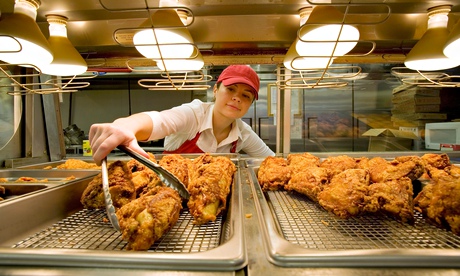
When the film What's Eating Gilbert Grape was released in 1993, the plot – featuring Johnny Depp and Leonardo DiCaprio as sons to a mother too obese to be lifted out of the house – seemed rather unusual, even unlikely. Two decades later, as Sarah Boseley, the Guardian's health editor, documents in The Shape We're In, Gilbert Grape scenarios are playing out up and down the UK. In 2012, 400kg 19-year-old Georgia Davis of Aberdare had to be carted out of her home on a specially reinforced stretcher after a wall was demolished and a bridge constructed to make way for her. Also that year, a five-year-old was taken into care in Newport because she weighed 65kg, more than three times the expected weight for a girl of her age.
Sad, shocking exceptions? Certainly, yet reading Boseley's disturbing book will leave you in no doubt that the gloomiest predictions of a massive, looming obesity epidemic have been realised: 60% of people in the UK are overweight; a quarter of us are obese.
Boseley has no time for the notion that fatness is simply a failure of personal willpower, a case of "eating too much and doing too little", rather she voices a cool, rational anger at the forces that swell the nation's waistband. Britain's laid-back attitude to junk food was exhibited when Margaret Thatcher welcomed McDonald's HQ to her constituency in 1982, and no government since has had the guts to curb the rapacious profiteering of the junk food barons, settling instead for a series of utterly ineffective voluntary agreements on food labelling and marketing to children, carved up by corporate lobbyists and civil servants. Allowing the junk food industry to police itself is, she suggests, like putting Dracula in charge of a blood bank. As for this government's "nudge" campaign to encourage the population to eat more healthily, Boseley is scathing: "Change4Life's jolly little family of blob-like faceless people are likely to evoke nothing more than a yawn and a flick of the wrist to change TV channels."
Boseley also gives dieting short shrift: "If they [diets] worked, the diet industry would go out of business." While her general point is that people who want to be thinner need to change their diets, not go on a diet, she weakens her attack by choosing worst-case examples. The breatharian diet, for instance: who follows that near-mythical regime?
The Shape We're In is a sobering store of reflections and images of the obesity epidemic. Boseley's intention was to look into its causes and consequences, and she succeeds more with the latter than the former. She relies heavily on interviews with oft-quoted figures in the healthy eating establishment, and as a result, does not challenge its orthodoxy. She draws no distinction between the corrupted vegetable oils used to fry fast food, for example, and the natural fats in meat and butter. "Fat is a problem," she tells us bluntly, damning the lamb chop from grass-fed sheep along with the KFC chicken nugget.
It is a pity that Boseley did not consult a broader range of health commentators. The anti-sat-fat consensus is melting. The very concept of calories as a useful measure of healthy eating is under sustained attack. About time too: a high-calorie avocado is a lot better for you than a can of diet cola and a fat-free bagel. Until such alternative "eat real food" thinking is enshrined in government healthy-eating advice, our shape will continue to deteriorate.

